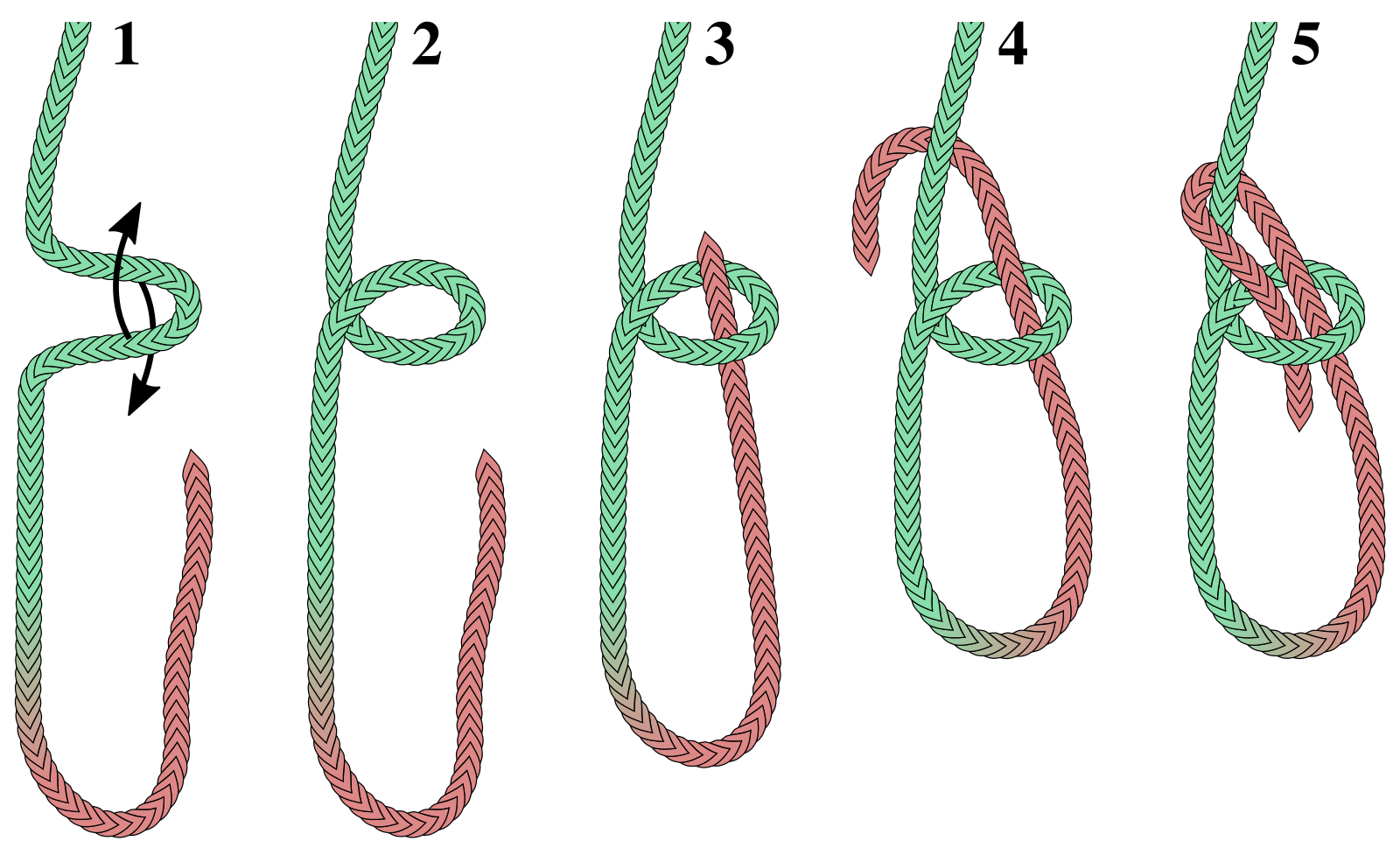|
French Bowline
{{unreferenced, date=September 2013 Some consider that a French bowline is the same as a Portuguese bowline, i.e. a bowline with two loops that can be used as a bosun's chair. A different knot is however also known as a French bowline. This form of bowline is similar to a standard bowline but there are several loops so that there is less likelihood of damage to a delicate object secured by the bowline. As with a standard bowline, the knot cannot tighten. Pressure is distributed over a wider area than in the case of a standard bowline. The main advantage of this method is that the knot can be tied with one hand. A convenient way to tie a French bowline can be: File:French1A.JPG, 1. Wind the running end several times round the object to be tied, leaving enough running end for one further turn. File:French2A.JPG, 2. Form a loop in the standing end This page explains commonly used terms related to knots. B Bend A bend is a knot used to join two lengths of rope. Bigh ... [...More Info...] [...Related Items...] OR: [Wikipedia] [Google] [Baidu] |
Portuguese Bowline
The Portuguese bowline ( pt, Nó volta do calafate; also known as the French bowline and Lisbon surprise) is a variant of the bowline with two loops. The two loops are adjustable in size. Rope can be pulled from one loop into the other, even after tightening. The knot can be used as a makeshift Bosun's chair. Tying It is tied in a way that is similar to regular bowlines. File:Portuguese Bowline step 1.jpg, Make an overhand loop (loop with the working end on top). File:Portuguese Bowline step 2.jpg, Put the working end through the loop. File:Portuguese Bowline step 3.jpg, Put it through again. From here, the steps are the same as the regular bowline. File:Portuguese Bowline step 4.jpg, Put it around the standing end and back through the loop. See also *List of knots This list of knots includes many alternative names for common knots and lashings. Knot names have evolved over time, and there are many conflicting or confusing naming issues. The overhand knot, for example, is a ... [...More Info...] [...Related Items...] OR: [Wikipedia] [Google] [Baidu] |
Bowline
The bowline ( or ) is an ancient and simple knot used to form a fixed loop at the end of a rope. It has the virtues of being both easy to tie and untie; most notably, it is easy to untie after being subjected to a load. The bowline is sometimes referred to as ''King of the knots'' because of its importance. Along with the sheet bend and the clove hitch, the bowline is often considered one of the most essential knots. The common bowline shares some structural similarity with the sheet bend. Virtually all end-to-end joining knots (i.e., bends) have a corresponding loop knot. Although the bowline is generally considered a reliable knot, its main deficiencies are a tendency to work loose when not under load (or under cyclic loading), to slip when pulled sideways, and the bight portion of the knot to capsize in certain circumstances. To address these shortcomings, a number of more secure variations of the bowline have been developed for use in safety-critical applications, or by s ... [...More Info...] [...Related Items...] OR: [Wikipedia] [Google] [Baidu] |
Knot
A knot is an intentional complication in cordage which may be practical or decorative, or both. Practical knots are classified by function, including hitches, bends, loop knots, and splices: a ''hitch'' fastens a rope to another object; a ''bend'' fastens two ends of a rope to each another; a ''loop knot'' is any knot creating a loop; and ''splice'' denotes any multi-strand knot, including bends and loops. A knot may also refer, in the strictest sense, to a stopper or knob at the end of a rope to keep that end from slipping through a grommet or eye. Knots have excited interest since ancient times for their practical uses, as well as their topological intricacy, studied in the area of mathematics known as knot theory. History Knots and knotting have been used and studied throughout history. For example, Chinese knotting is a decorative handicraft art that began as a form of Chinese folk art in the Tang and Song Dynasty (960–1279 AD) in China, later popularized in t ... [...More Info...] [...Related Items...] OR: [Wikipedia] [Google] [Baidu] |
Knot
A knot is an intentional complication in cordage which may be practical or decorative, or both. Practical knots are classified by function, including hitches, bends, loop knots, and splices: a ''hitch'' fastens a rope to another object; a ''bend'' fastens two ends of a rope to each another; a ''loop knot'' is any knot creating a loop; and ''splice'' denotes any multi-strand knot, including bends and loops. A knot may also refer, in the strictest sense, to a stopper or knob at the end of a rope to keep that end from slipping through a grommet or eye. Knots have excited interest since ancient times for their practical uses, as well as their topological intricacy, studied in the area of mathematics known as knot theory. History Knots and knotting have been used and studied throughout history. For example, Chinese knotting is a decorative handicraft art that began as a form of Chinese folk art in the Tang and Song Dynasty (960–1279 AD) in China, later popularized in t ... [...More Info...] [...Related Items...] OR: [Wikipedia] [Google] [Baidu] |

